|
November 5, 2014: First night in the palace! The big coop is complete, so tonight the old coop was shuttered and the ladies were put to bed in their new coop. They are creatures of habit, so there was a fair bit of consternation as they were denied entry to the old coop and forced to take up residence in the new one. Eventually all were rounded up, though, and jostling for the prime rost near the window commenced even though there are now plenty of roosting bars for everyone.
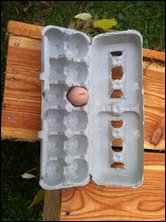 November 1, 2014: Success!!! This morning one of the Rhode Island Reds laid the very first Geneva Peeps egg. She laid it right on the floor in the corner of the new coop, then casually walked away as if nothing had happened. A few hours later, with considerably more fanfare, a Barred Rock (ThunderChick, we think) laid the second egg precariously atop the new shelf in the new coop, a delicate light tan egg with a slender shape. ThunderChick celebrated with the "I Just Laid an Egg" song at full volume. November 1, 2014: Success!!! This morning one of the Rhode Island Reds laid the very first Geneva Peeps egg. She laid it right on the floor in the corner of the new coop, then casually walked away as if nothing had happened. A few hours later, with considerably more fanfare, a Barred Rock (ThunderChick, we think) laid the second egg precariously atop the new shelf in the new coop, a delicate light tan egg with a slender shape. ThunderChick celebrated with the "I Just Laid an Egg" song at full volume.
October 30-31, 2014: Two days of coop-building commenced in earnest, as the hens are dangerously close to laying. With boards cut and windows painted, it was time to put it all together. Co-op members turned out in droves to cut the hemlock into siding, mount the windows, mount the back (human) door and front (chicken) door, place the nesting boxes, hang the roosting bars (which used to be bike racks, the very same poles we used for the fence posts), and tack up the batten. After two solid days of work, the coop is very nearly ready for occupancy!
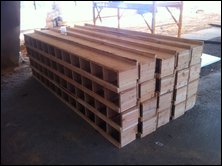 October 29, 2014: Jackie and I took a trip out to Seneca County to pick up 30 rough cut hemlock boards, and a pile of rough cut batten, from Levi Byler's sawmill. Mr. Byler is in the midst of starting his own egg-laying production, with 3,500 pullets on the way. He was kind enough to build two extra nesting box structures (with 12 boxes per structure) in addition to the dozens of boxes he's building for his own flock, so we now have 30 nesting boxes in anticipation of the first egg. To get the 15' boards back to Geneva, Red Jacket Orchards was kind enough to lend us a box truck for the trip. October 29, 2014: Jackie and I took a trip out to Seneca County to pick up 30 rough cut hemlock boards, and a pile of rough cut batten, from Levi Byler's sawmill. Mr. Byler is in the midst of starting his own egg-laying production, with 3,500 pullets on the way. He was kind enough to build two extra nesting box structures (with 12 boxes per structure) in addition to the dozens of boxes he's building for his own flock, so we now have 30 nesting boxes in anticipation of the first egg. To get the 15' boards back to Geneva, Red Jacket Orchards was kind enough to lend us a box truck for the trip.
October 18, 2014: Six students from Hobart & William Smith Colleges (HWS) come to the co-op as part of HWS's Day of Service. They spend two hours weeding, picking up litter, and digging out the first three raised beds. Under grey skies and despite the chilly temperatures we have much fun (and learn some things!).
October 11, 2014: Middle-school students from St. Mary's in Canandaigua visit the co-op to learn about our operations. We talked about solar power, rainwater catchment, local food, the life of a chicken (free range vs. industrial production), composting, and a million other things. Then we spent some time watching the hens and attempting to catch them for petting and snuggling. A good time was had by all.
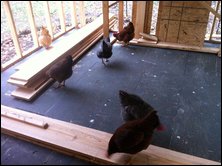 October 4, 2014: Co-op members come together to continue building the new coop. With the walls framed and square, the roof is constructed on top. It's made of 1/2" plywood laid upon 2x6 joists and covered with tar paper and capped by corrugated steel roofing. The chickens signal their approval by perching on the window sills. October 4, 2014: Co-op members come together to continue building the new coop. With the walls framed and square, the roof is constructed on top. It's made of 1/2" plywood laid upon 2x6 joists and covered with tar paper and capped by corrugated steel roofing. The chickens signal their approval by perching on the window sills.
October 1-2, 2014: For two mornings we work on the new coop, framing the walls and raising them onto the base previously built. It's going to be a big coop - 12'x13' footprint and 8' feet high in the back, sloping down to 6' high in the front. It covers most of the raised base but leaves about 3' in front for rain barrels.
September 20, 2014: With the solar panels being rapidly installed, we begin construction of the second layer of fencing toward the front of the land. The new fencing will be in the same style as the back fencing and will double the size of the chicken's roaming area. A gate will separate the back pasture from the front pasture, allowing for pasture rotation and ultimately healthier grass.
August 21, 2014: Geneva Peeps responded with a letter of our own, stating that activities at the co-op would not halt because approval had been granted.
August 20, 2014: With everything seemingly going so well and 23 happy hens roaming their new castle grounds, the City of Geneva sent a letter requesting a halt to the project, a relocation of the hens to a different site, and no activity until it could be brought before the Zoning Board of Appeals at the end of September. Apparently a small but vocal contingent of residents had bent the ear of impressionable City Councilors and succeeded in eliciting some action. Despite approval already having been granted in the forms of a Building Permit and unanimous vote of the Planning Board, the City decided that an ordinance had been overlooked and required further scrutiny.
August 16, 2014: Saturday dawned full of hope as we endeavored to finish the fence. We pounded the remaining posts into the ground and laid brick at the base of the fence already placed. We came across an immovable concrete pad at the very back of the site, which we would need to lay the fence over - there was no way to dig it out. We unearthed about a thousand more bricks and were immmediately able to reuse them as fortification at the base of the fence.
By noon we had strung fence all the way around, and it was time to let the chickens out into their much-bigger yard. They responded with great rejoicing, if that's indicated by scratching and pecking with vigor. We scooped dirt back into the trench we had dug and checked for weak spots. Stage II of the fence was complete.
August 14, 2014: As the chickens had already cleared everything green from their fenced area, the Peeps got together in the afternoon for a workday to expand the fencing out into the yard. The first task was to dig a trench; we wanted to sink the bottom of the fence at least 8 inches into the ground to prevent little animals (and chickens) from burrowing under. Then we needed to pound another six posts into the ground, easier said than done with bricks and concrete waiting just under the surface of the dirt. Finally, it was time to string the fencing between the posts and secure it with zip-ties.
By the end of the evening, we had strung fencing about 2/3 of the way around the back of the yard and were out of fencing. I needed to buy about 100' more before the next workday, two days later.
August 7, 2014: Ryan Wallace and I met John Brennan, code enforcement officer for the City of Geneva, at the site to show him around. He expressed approval of the shed and the coop, making note of the cuteness of the chickens, and then asked some questions about the solar. He was on a fact-finding mission, and I learned some things, too, as Ryan educated the both of us. The solar panels are going to be about 7' wide and about 70' long, four arrays standing 18' apart along the west side and middle of the property.
July 25, 2014: We finished hanging the fence (at least 7' tall and fortified by bricks at the base) and stood back... we had arrived at a significant moment. The site was ready to host live, curious, ever-hungry and thirsty chickens. The first group of nine arrived and we watched them in wonder. They inspected everything, making special note of the ample bugs and other tasty things seemingly everywhere. As the sun set, we placed them into the coop and they signaled approval by hopping onto the roosting bars. With full waterer and feeder, we closed the coop and said good-night at State Street for the very first time.
July 24, 2014: With chicks frantic to get outside, we began erecting the fence in earnest. In the interest of time, we decided to concentrate on a smaller area in the immediate area of the coop, then at a later time we would expend out into the yard. Whatever we came up with, it would be better than the small cardboard boxes they had been inhabiting for the previous 6 weeks.
With reclamation in mind, we decided to use old steel bike racks for the fence posts. Being 12 feet long and painted against rust, they also featured a small diameter that would minimize visual distraction while viewing the chickens. Although narrow, the posts were challenging to drive into the ground, as that chunk of land is full of old concrete and bricks from the last use. Apparently the City dismantled the old factory, dug a big hole, and buried everything on-site. Now it was our turn to deal with it.
July 23, 2014: We rigged up two rain barrels and a gutter system to provide fresh water for the chickens. There is no city water service to the site, but we wanted to do this anyway as part of the demonstration project. The old barrels used to store sherry made by a local farmer, and the coop roof was pitched perfectly to feed into the gutter at the back.
To add some color and flair, Jackie, Henry, and Sophie spruced up the coop with some paint. They painted the doors red and added "Geneva Peeps" to the front overhang. Jackie showed off some paint wizardry by drawing the running chicken logo on the front of the coop and the side of the kitchen. Sophie dedicated herself to painting the window frame, adding a nice red accent to the front of the structure.
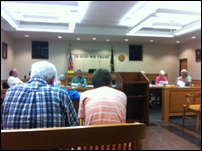 July 21, 2014: Before proceeding any further, we needed to present the project (chickens, solar panels, water storage, etc) before the City of Geneva Planning Board. That Monday evening, with the Peeps project the only one on the agenda, nine Planning Board members spent four hours completely vetting the project. Citizens had the chance to express concerns as well as support, and every detail was scrutinized. July 21, 2014: Before proceeding any further, we needed to present the project (chickens, solar panels, water storage, etc) before the City of Geneva Planning Board. That Monday evening, with the Peeps project the only one on the agenda, nine Planning Board members spent four hours completely vetting the project. Citizens had the chance to express concerns as well as support, and every detail was scrutinized.
By the end we had secured approval from the Planning Board by a unanimous 9-0 vote.
July 20, 2014: We visited Brian, the coop seller, way out in the country and determined the coop was a beauty. Red Jacket Orchards had generously agreed to lend me a box truck for the pick-up, and it's a good thing because nothing else would have been adequate for the job. The coop just fit into the back of the truck, and only after removing the "kitchen" addition and some of the base. A strong and determined crew stuffed it into the back of the truck and an even larger crew was there to unload it. After some leveling and reassembly, the shiny new coop was ready for chickens! (Well, almost. Concerned Peeps spent some time adding extra flooring, wire mesh, and other little touches to make sure the structure would be draft-free and impenetrable to wild animals.)
July 19, 2014: With the base built, we were ready to assemble the rest of the coop. However, we had been simultaneously watching craigslist and lo and behold something wonderful appeared: a fully-built coop for sale over in Canandaigua. We decided to have a look.
July 19, 2014: Co-op members came together to ready the site for the rapidly-growing and ready-to-be-outside chicks. Three major tasks stood before us: securing a water supply for the chickens, building or procuring a coop, and building a fence.
We started a coop based on plans we found on the interweb. Our vision was lofty, and we wanted it to be a pleasant, safe, dry, and secure home for the ladies. The plans described an 8x12 footprint, which would house anywhere up to 45 hens - plenty of space. The blueprint had the coop resting on bare ground, but we decided to elevate it so we could secure it against varmints and maybe keep it a little warmer in the winter.
So we started by building the base, a platform about 50% larger than the 8x12 coop footprint so we could include space for rain barrels (they would supply the fresh water for the chickens: major task #2). Many hands made light work, and the base came out quite nice:
June 24, 2014: Chicks are growing! Four families have been caring for the 25 chicks for two weeks now, and their growth is staggering. Feathers are coming in, they have doubled in size, and many of them are now roosting. Slowly but surely, name are being selected: Lemon, ThunderChick, Martha, Pete, Daisy, Buffington, and Rosie are no longer anonymous.
June 23, 2014: The City of Geneva decides to require more than a Building Permit for the site elements. A full Site Plan, Special Use Permit, and Environmental Review (SEQR) are now required, along with an appearance before the Planing Board and Zoning Board in July.
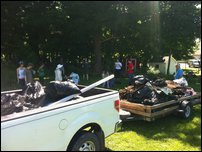 June 7, 2014: Site clean-up day. Almost every member of the co-op and their families turned out to remove trash, weeds, and various other things from the State Street lot. We don't know how long the lot has been vacant, but in that time a large collection of debris has accumulated, mostly in the back woods. We took a big load to the dump and cleared out some of the wood, bricks, and cinder blocks as well. We put these items aside, as there might be a use for them in the co-op. June 7, 2014: Site clean-up day. Almost every member of the co-op and their families turned out to remove trash, weeds, and various other things from the State Street lot. We don't know how long the lot has been vacant, but in that time a large collection of debris has accumulated, mostly in the back woods. We took a big load to the dump and cleared out some of the wood, bricks, and cinder blocks as well. We put these items aside, as there might be a use for them in the co-op.
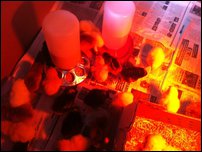 June 6, 2014: Arrival of the chicks. Twenty-five little girls were ordered from Meyer Hatchery in Ohio, and 26 arrived - an extra Barred Rock had been thrown in for good measure. Upon arrival, two of the chicks were not looking so good - apparently the two-day journey through the U.S. Postal Service had not been kind. One died within two hours of arrival, the second died two days later. Very sad. The remaining 24 chicks were distributed to four families for caretaking and raising until they get their feathers. June 6, 2014: Arrival of the chicks. Twenty-five little girls were ordered from Meyer Hatchery in Ohio, and 26 arrived - an extra Barred Rock had been thrown in for good measure. Upon arrival, two of the chicks were not looking so good - apparently the two-day journey through the U.S. Postal Service had not been kind. One died within two hours of arrival, the second died two days later. Very sad. The remaining 24 chicks were distributed to four families for caretaking and raising until they get their feathers.
May 28, 2014: Soil test results received. The soil does not contain harmful levels of heavy metals, making it safe for chickens and planted vegetables.
May 8, 2014: Solar panels contracted. We're ordering 40 panels, which will produce about 9 kilowatts of power. A couple additional arrays might be located on the site as well, owned by other parties, and they will become part of the chicken run. Cover from predators and more square footage for rainwater catchment!
May 4, 2014: first meeting of the Peeps! We are off and running.
|
